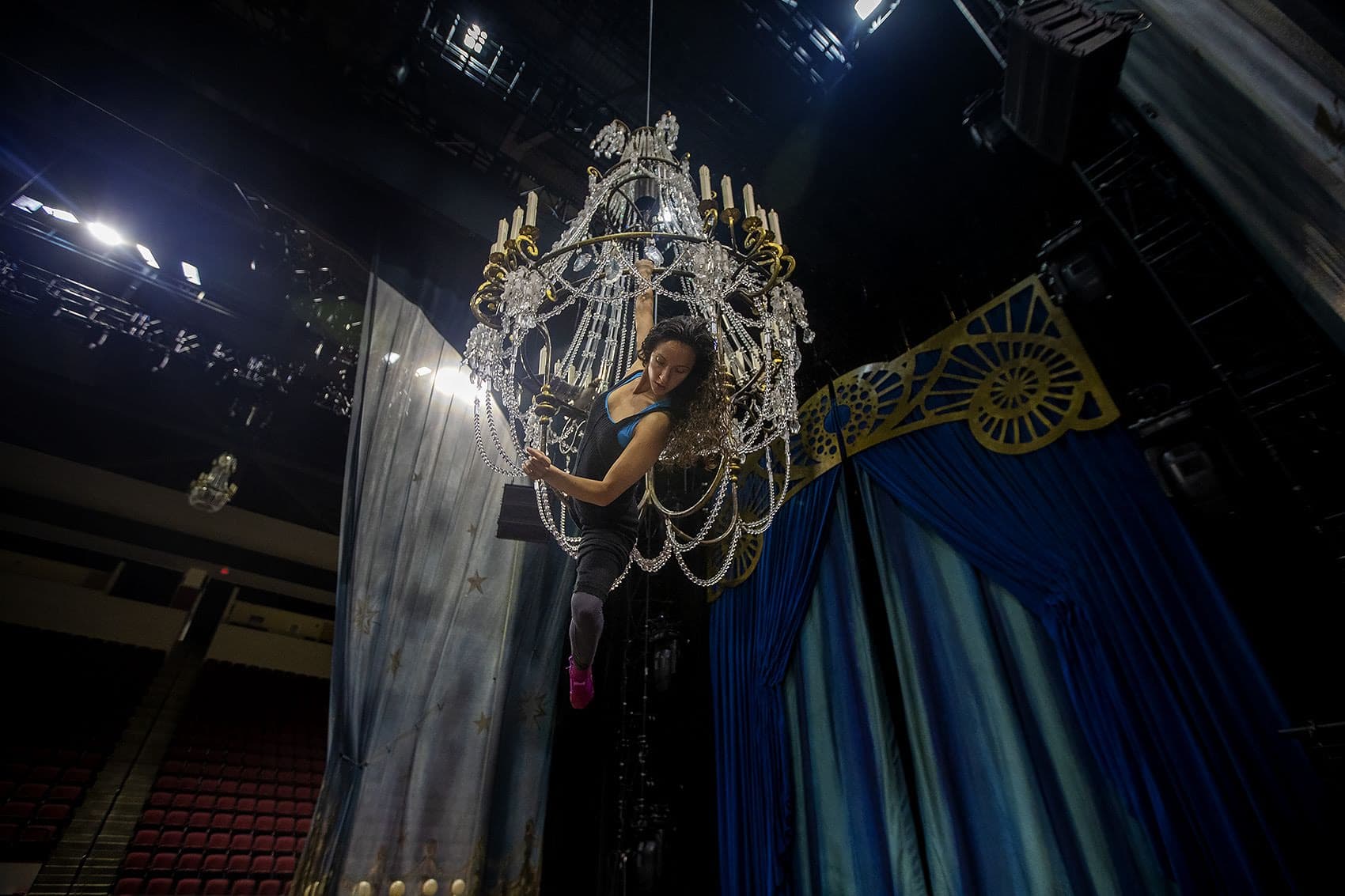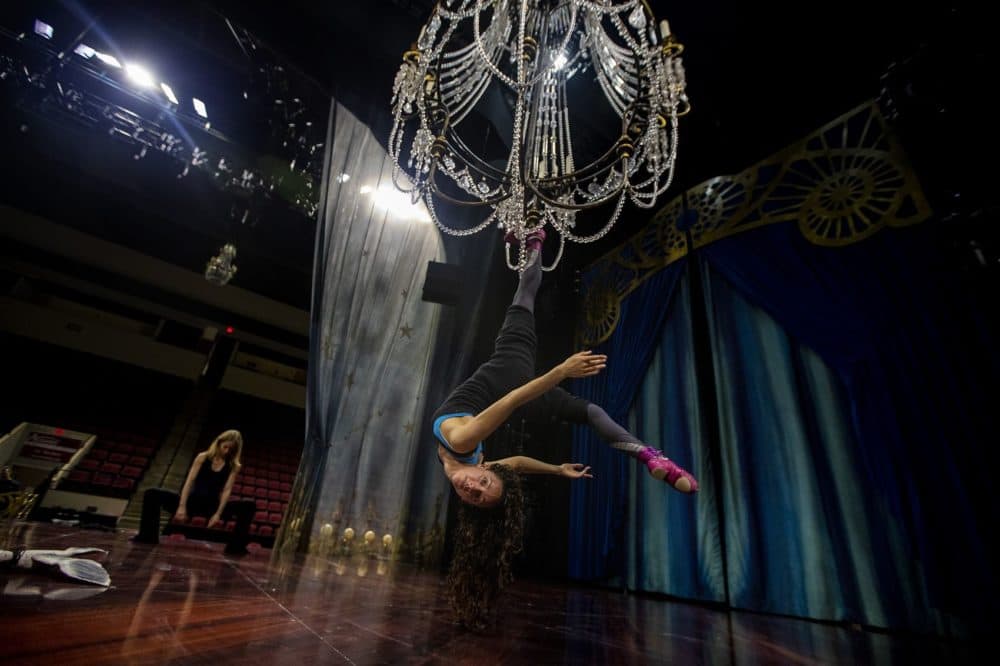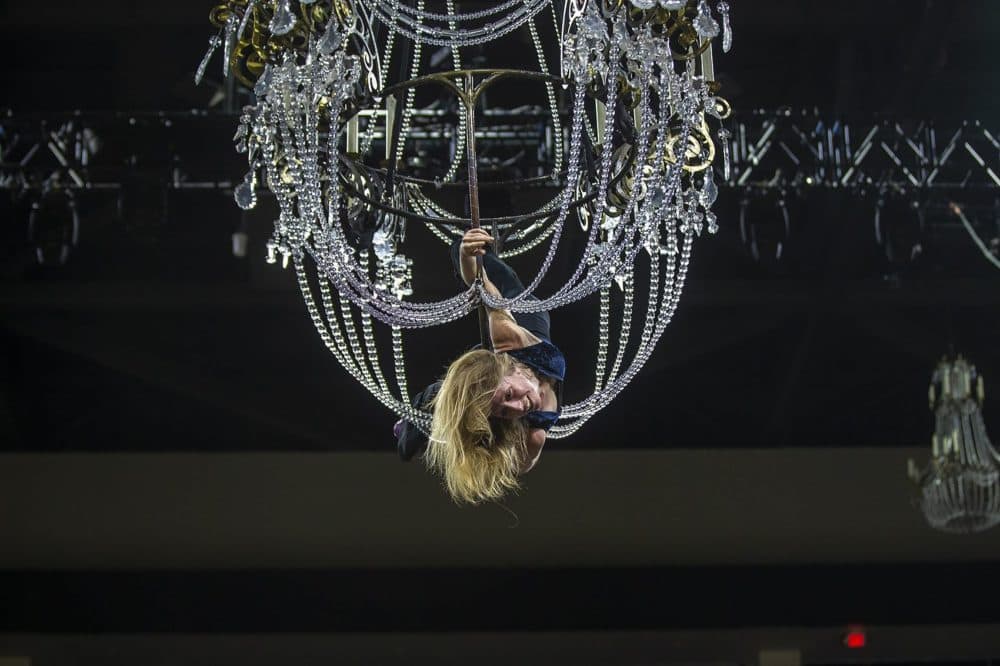Advertisement
Spinning Hula Hoops And Swinging From A Chandelier: Life As A Cirque Du Soleil Performer
Resume
Cirque du Soleil has come a long way since its founding by two French-Canadian street performers in the 1980s.
It translates to "Circus of the Sun" and is now dubbed the largest theatrical producer in the world. Cirque du Soleil's 28 shows entertain crowds in huge arenas and big tents.
One arena show currently on tour is called "Corteo." At a recent practice, gymnasts catapulted each other high up into the air and an acrobat dangled from a free-standing straight ladder.
Aerialist Sante Fortunato suspends from a large glass chandelier from high above the stage in the show. This is routine for her now, but she says, she used to be afraid of heights.
"When I first got into circus school, I was afraid of heights," Fortunato (@Santedf) tells Here & Now's Jeremy Hobson. "I would just practice tricks at a low height, and then all of a sudden, you feel like, 'Oh, I feel comfortable.' And then like the coach brings you a little higher. 'Oh, this feels fine.' And then a little higher, and then you trust yourself."
"Corteo" is an Italian word meaning cortège or procession. Partly inspired by a Federico Fellini film, the show follows a clown watching his own funeral take place. Fortunato plays the part of a past lover, all while dangling from a glass chandler and spinning multiple hula hoops while balancing on one leg.
"It's not all just about tricks. That wouldn't be a show," she says. "There are some moments that are a little bit more difficult than other moments, and in those moments, you need to find that balance between focus and also still being in character. But otherwise, having an emotion and a direction and a character where you're going makes everything even just more enjoyable and more fun and in a way, easier."

Interview Highlights
On how she started doing aerial acrobatics
"I did aerial hoop at the National Circus School Of Montreal along with hula hoops and contortion, and then I started working like for different companies all around the world. And then I started with Cirque. The job opportunity was to work on an arrow chandelier, which I had never done before. If you're an aerialist and you do like dance trapeze or aerial hoop, you can learn how to do aerials on a chandelier.
"I honestly just had a lot of fun. I grew up doing dance for 10 years, and I did rhythmic gymnastics for five years, and then I heard about a circus college in Montreal. And then I applied and got in and I didn't really know much about it. I just live life in the moment, and I enjoyed what I was doing at the moment, and I still enjoy what I'm doing today."
On the challenge of performing with multiple hula hoops
"That's probably the hardest part of the show. Well, a lot of people are like, 'Oh, aren't you stressed being in the air?' But that for me, is more relaxing, hula hoops, because I have a lot of hoops, and if I do something slightly wrong, I will drop the hoops and I don't want to drop. And so I need to be super focused and super on point. And sometimes I'm standing on one leg and spinning seven hoops on different parts of my body. So if I lose my balance a bit, then it's not only I lose my balance and I fall, I also will throw seven hoops in the air, which I don't want to do. So that's challenging but fun at the same time."

On watching people in the audience react
"I feel like I saw a woman once be like, 'Wow!' and like I could just see ... the sincerity in her expression. Or I even just other moments in the show where it's more just like character work, not an acrobatic act, and you can really get to look into the audience and see just a little kid be super happy and like just so engaged, and that's really rewarding. And you can see them almost like dreaming and with you and just being inspired, and that's definitely an awesome thing to be able to do."
On why Cirque du Soleil shows are so popular
"I think because it is acrobatically amazing, and it is also like emotionally amazing. It is artistic. There's so much that's put into the costumes, into the makeup. There's so much artistry, not just in acrobatics, like in makeup, in theater, in set making, in every single detail. Like ... when we're in Montreal, we don't just rehearse our acrobatics. We have acting classes. We have improv classes. Sometimes they make you do movement classes or all kinds of things. So it's just the combination of many art forms together to make circus even more 'wow' — emotionally and physically."
Lynn Menegon produced and edited this interview for broadcast with Tinku Ray. Samantha Raphelson adapted it for the web.
This segment aired on June 21, 2019.
